Ripple Effects
Acknowledgements ... Biography ... Ripples
This website is dedicated to the memory of Courtney Milne – all of this was seeded by his photography and our work and life together ...
With special thanks to Rosa Droescher ... teacher, mentor, friend ... who introduced Courtney and me to the wonders of inner vision ... led me on pilgrimage to connect with the Black Madonna and sacred land energies ... and guided me in this model of Landscapes of Consciousness.
... we are all beautiful drops of borrowed light to each other ...
... these words from Bianca Sparacino portray my special thanks to the many people over the years who have trusted me to enter into their inner landscape experience in personal sessions or in workshops ... thank you for being open, vulnerable, and curious ... and for the endless support from all our friends worldwide.
Thanks to my dream group, Christine, Linda and Nicole, and to Corrinne who started me on the path ... to my sister Lorraine, for your ever-present support, editorial suggestions and questions that clarify ... to Pat Katz for starting our journey with Marcel Proust’s invitation: the real voyage of discovery is not in seeking new landscapes but in having new eyes.
All Courtney Milne images are courtesy of and available through the University of Saskatchewan Library and Archives. Special thanks to Cheryl Avery and the Archives for caretaking the Courtney Milne Collection, for sharing our vision, for catching the wisdom and the whimsy, and for making the Pool of Possibilities daily
e-calendar
available (the ultimate ripple effect!). Thanks to Dr. MJ Barrett and your graduate students for sharing your Inner Landscapes
experiences with Courtney’s images in the film project: Multiple Ways of Knowing in Environmental Decision Making, spearheaded by Sandra Panko ... and to Dr. Lorraine Holtslander for inviting me to share my vision with nursing students and professionals in
The Palliative Journey.
It hardly seems necessary to write a bio as all these web pages are an aspect of my life. My early background in nursing, counselling and then in business served me well in working with many varied situations and people over the years, broadening my worldview. Then for more than 20 years Courtney and I travelled the world photographing sacred places on all seven continents.
I did the research and planning, and of our
12 published books, I authored
The Pilgrim’s Guide, a companion travel book to
The Sacred Earth
-- and
Visions of the Goddess, landscapes reflecting the divine feminine in various cultures.

Having lived a life surrounded by beauty and possibility drew me into continuing this journey of working with Courtney’s mystical images to explore the mysteries in even deeper, more meaningful ways. My Inner Vision work (Portal 3) and Visual Echoes (Grace Notes) strike to the heart of that. The Inner Landscapes Process expands the work we started in 1988. My Gift of Change show is modelled on the many presentations Courtney created over the years, as another ripple effect of his creativity inspired me to share my experiences in reclaiming, reinventing and re-enchanting the life that flowed from our left-hand turn. Visitations from Feathered Companions and Feline Wisdom reflect on our intersection with the more-than-human world. The Pool Story is my witnessing of Courtney’s journey to the edges of his seeing, as background to the Mendel Art Gallery exhibition in 2011. I hope this website honors all that has passed and the fullness of the legacy left behind.
This image speaks to that journey. Courtney called it Shambhala, in recognition of the Buddhist kingdom said to be hidden ‘beyond the Himalayas.’ Immortalized in western enchantment as the utopian Shangri-la, perhaps it is revealed here in the golden mountain found in this tiny vignette of delicate fractures in opal rock. However, we are reminded by His Holiness, the Dalai Lama, who wrote the Foreword for The Sacred Earth book, that indeed, sacred places belong to the heart and mind, rather than to an earthly paradise.

The mythopoetic continues to lead the way, as symbol, myth and metaphor guide me to awaken my intuitive knowing and attend to my personal wisdom.
The header image of this section is one of a few of my own snapshots sprinkled throughout the website ... another example of Courtney’s ‘ripple effect’, in how my way of seeing matured along with his. This image portrays the gap between two liquids in a homemade salad dressing ... the interface is a bit ‘soft’ ... the image not quite sharp. I thought about trying to correct it, but then realized it was a great symbol ... even in the kitchen, waiting for the exquisite colours of the two layers to coalesce, watching what might emerge in that coming together, one finds another liminal space ... another Third Note.
Everything becomes a metaphor.
These final images are Courtney’s. He called them murals ... I see them as an unexpected portrayal of his own ‘ripple effect’, as he flipped the original image to the right, then to the left, creating a diptych, and maybe again for a triptych ... each step creates a new image, each being a ripple of the original, and of each other.
This icy creation captures the clear blue winter sky shining through the delicate frost patterns appearing on the window ... luckily photographed from the inside, as it was minus 32 degrees Celsius outside ... but despite the cold exterior, the lacy traces were soon to disappear in the wake of the penetrating low-angled winter sun.

This evocative pool mural is perhaps a good way to conclude ... echoing GK Chesterton:
The dignity of the artist is in his duty of keeping awake the sense of wonder in the world.
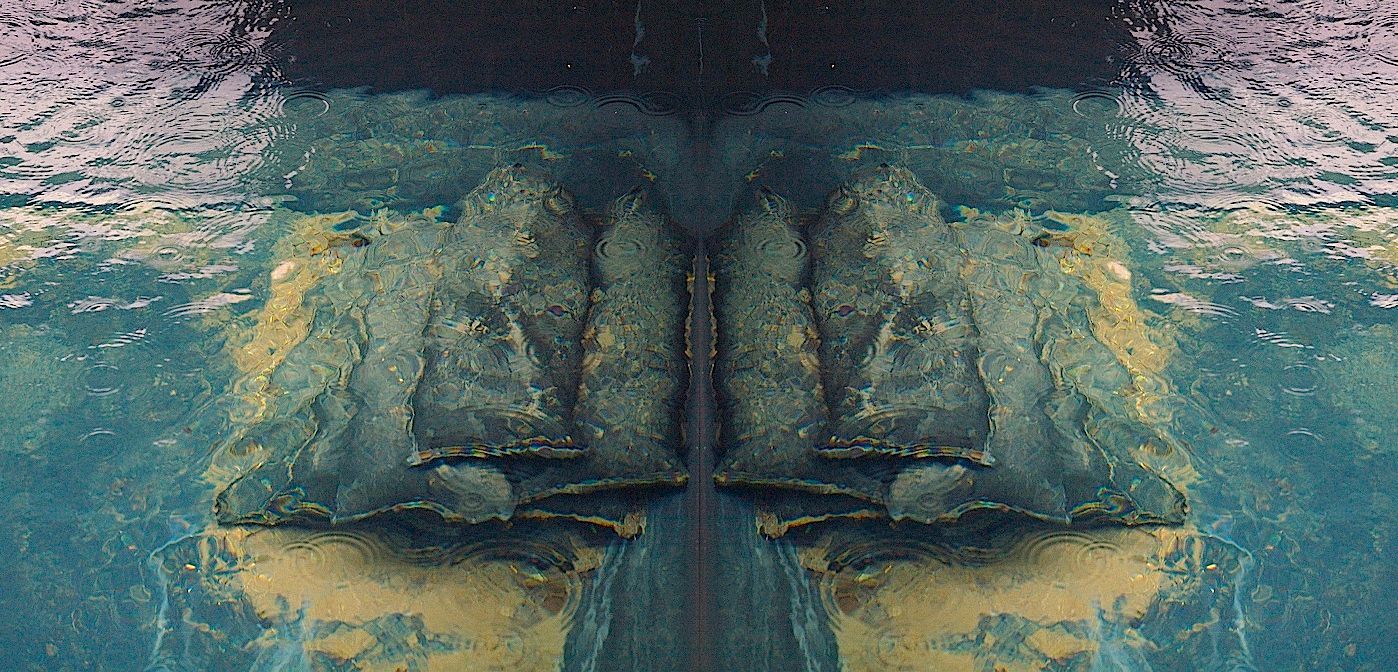
Visitations from Feathered Companions
Courtney and I had a rather sentimental relationship with owls, even if at a distance. The idea of them being around us was thrilling in itself. Seeing a long-eared owl nest in a grove of trees had been the impetus for us to purchase this pristine 80-acre rural property that has never been plowed ... it is an oasis of primordial Prairie landscape that a Cree friend suggested we call Keechitawin ... ‘creation smiles’ .... and the land did indeed smile on us ...

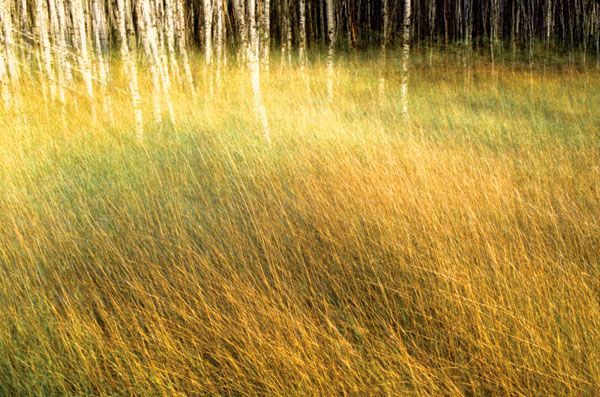
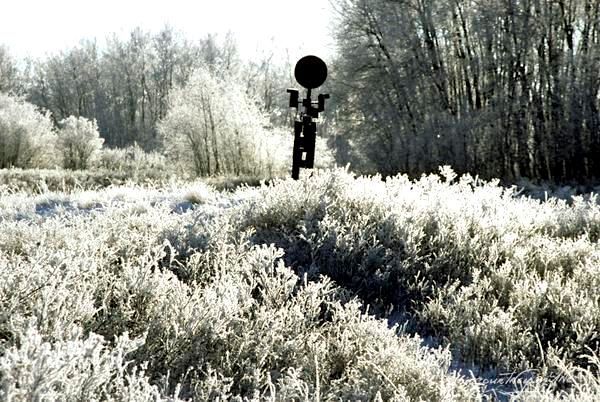
Even though we often heard different owl calls, it wasn’t until nearly fifteen years later that they made themselves visible.
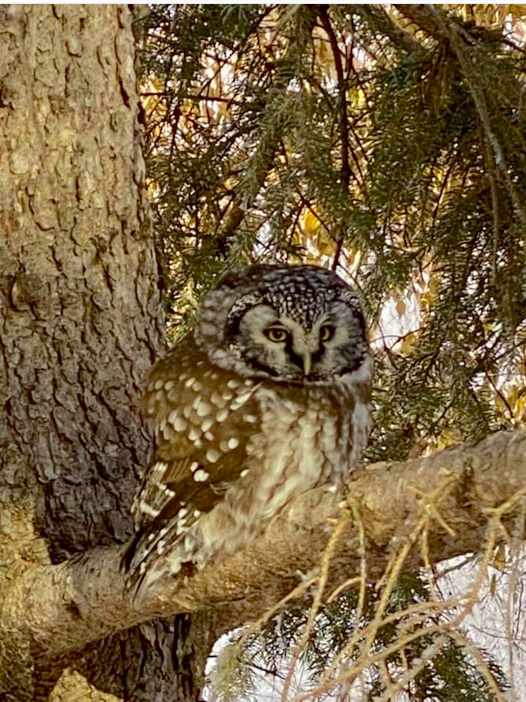
I had broken my ankle, resulting in being immobilized in a below-knee cast. Unable to handle stairs up to the bedroom, I was confined to the living room couch. Lying there, hour after hour, I spied this little Saw-whet owl in the evergreen outside the window, overlooking the pool ... and me. [image by friend Ted].
He came and went over several weeks, always nestled on that protected branch.
Once I was back to mobility, I did not see him again until five years later, after Courtney died.
But before these second experiences with the Saw-whet, another owl visitation then became even more astonishing. A month after Courtney died, I held a memorial for him which was attended by hundreds of people ~ on the day before what would have been his 67th birthday.
The next morning, Courtney’s birthday, I took my brother to the airport. On my return, as I sat at the dining room table for breakfast, a huge shadow crossed over the large picture window, and then veered sharply to the west ... and a Great Horned owl landed on the wood coping that framed the pool.
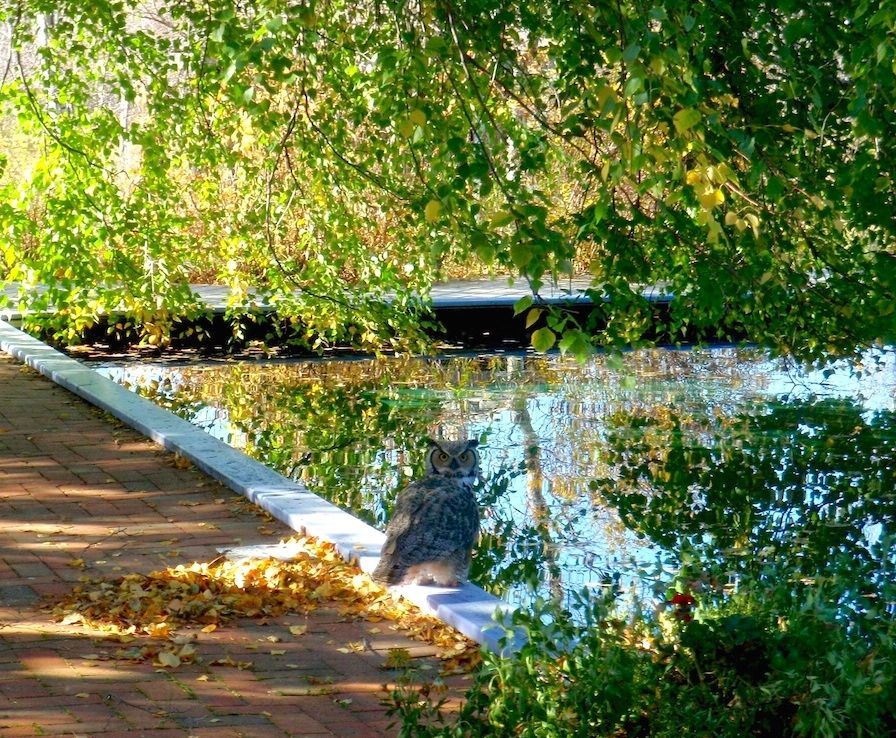

A friend and I were shocked into silence and stillness ... the owl walked up and down the planking as we held our breath ... I eventually crawled below the window to get my small camera and ventured closer to take some shots through another window directly opposite the pool ... the owl continued walking as we watched for many minutes. Finally, I felt compelled to go outside, and as I quietly opened the door, he flew up into the weeping birch tree, and then off into the meadow. This felt like an acknowledgement and visitation from Courtney.
Owls are part of many cosmologies ... myth and mystery abound, as it is said that owls embody spirits of the dead ... and were mystical companions to the Greek goddess, Athena, and other feminine deities. Several indigenous traditions have stories of an Owl Being that stands at a fork in the road in the sky - in the Milky Way star path that leads to the land of the dead. Among the Ojibwa, one word for the passageway over which the dead had to pass to the afterlife is the Owl Bridge.
The owl is described as a bird of the night, a symbol of the darkness within, the place in which humans hide their secrets. ... in some traditions he is known as the ‘night eagle.’
This portrays another serendipitous intersection, as in 1993 Courtney was given a name by a Cree Nation in Manitoba: they called him Standing Strong White Eagle Man. One of our treasured pieces of art is this eagle sculpture, a minimalist work by Lynn Branson, carved out of a discarded moose rack. This is a very early piece from Lynn, who has since become internationally renowned -- at rawearthcarvings.com

Many other echoes came out of this visitation. Our neighbours to the north reported they were having coffee on the porch of their little cabin in the woods when an eagle swooped down and landed in a tree, watching them for several minutes. They did not know that Courtney had died that morning. And they had never had such a visitation before.
Other friends far and wide reported independent encounters with bird companions, owls and eagles ... all synchronized in some meaningful way with Courtney’s death, or at times when they were remembering him.
In subsequent years I occasionally arrived home to see the Great Horned fly along our long driveway, swooping from grove to grove.
I then had more visitations from the Saw-whet. Despite being described as a nocturnal species that stays camouflaged in foliage during the day, this little one visited numerous times, sitting in the winter sun on a block of petrified wood tucked in the snow against the house. He gazed sweetly at me, blinking his eyes and allowing me to come within two feet to take pictures - right outside the back door, on our huge south patio.

Many other winged creatures visited us over the years ... Chickadee, Flicker, Hawk, Redpoll, Hummingbird ... and the commonplace Magpie, the black and white ubiquitous scavenger ... a noisy nuisance ... along with fellow members of the raucous crow family. But here, in the repose of death, his glossy black feathers reveal an unexpected gift in this panorama of iridescent color ... another reminder of how we might see ‘with new eyes’ as we pay tribute to another hidden beauty that lies beneath our usual ken ...
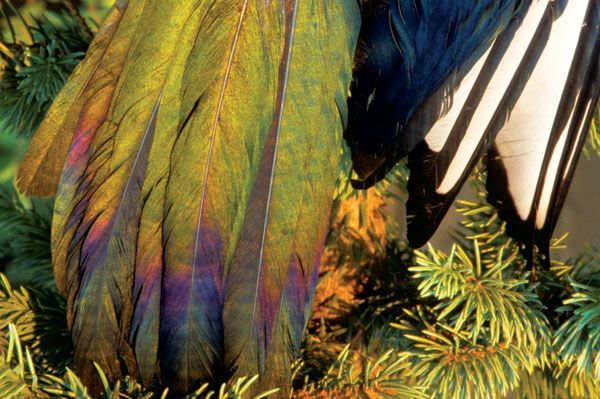
FelineWisdom ...
Over the years we invited a series of 4-legged cat buddies to share our home. There was an abundance of love and purrs in all these beings who insinuated themselves into our life and became invaluable companions ... and teachers.
Perhaps one of the best examples of the power of these relationships is this speech by Courtney at the 1994 opening of his Sacred Earth Exhibition at the Canadian Embassy in Tokyo ...
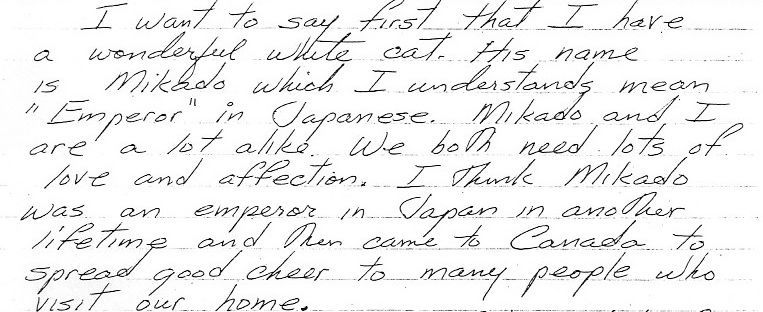
This image of Mikado perched on the wood statue in the garden reinforces Courtney’s impression that indeed, Mikado was an ‘emperor’ ... always on top!

Courtney's comments are reminiscent of the Japanese honouring of the spirit in all nature ... as in this swan grooming under the watchful gaze of the sacred mountain, Fuji, reflected in the sacred waters of Lake Yamanaka.

He continued: ...
therefore it is fitting that if Japan has sent me so much love in my life that I return this love by sharing my photographs with you. ... more than anything else, they are about love, and show the places on our planet where people go for love, healing and enlightenment. I hope today, and while the Sacred Earth Exhibition remains here, that you and many others will feel blessed by viewing my work. The theme of these photographs is universal and I offer you this exhibition in the spirit of peace and universal understanding among nations.
Many joyful years passed with our companions until the day came for Mikado to transition to his next incarnation ... I’m not sure which of his nine lives that was, but Courtney was then moved to write this tribute, Mikado’s Ten Cat-mandments, which perhaps says as much about Courtney as it does about Mikado ...
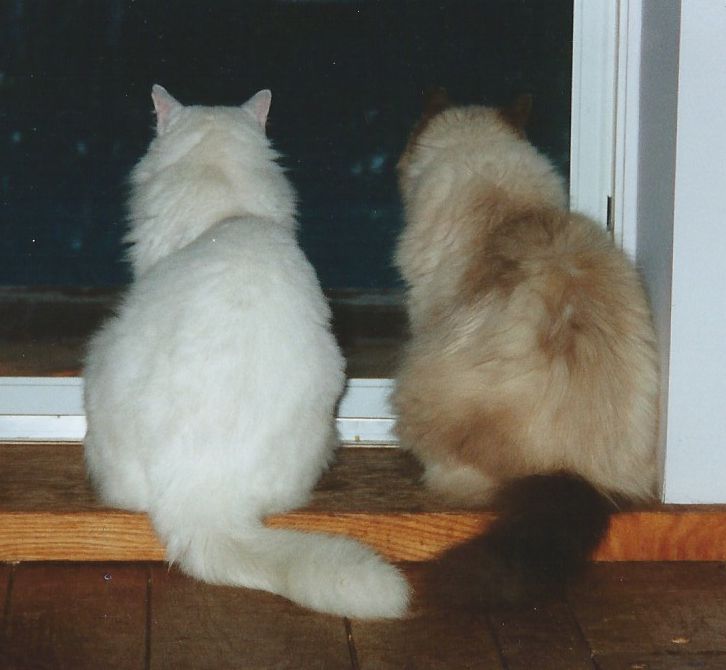
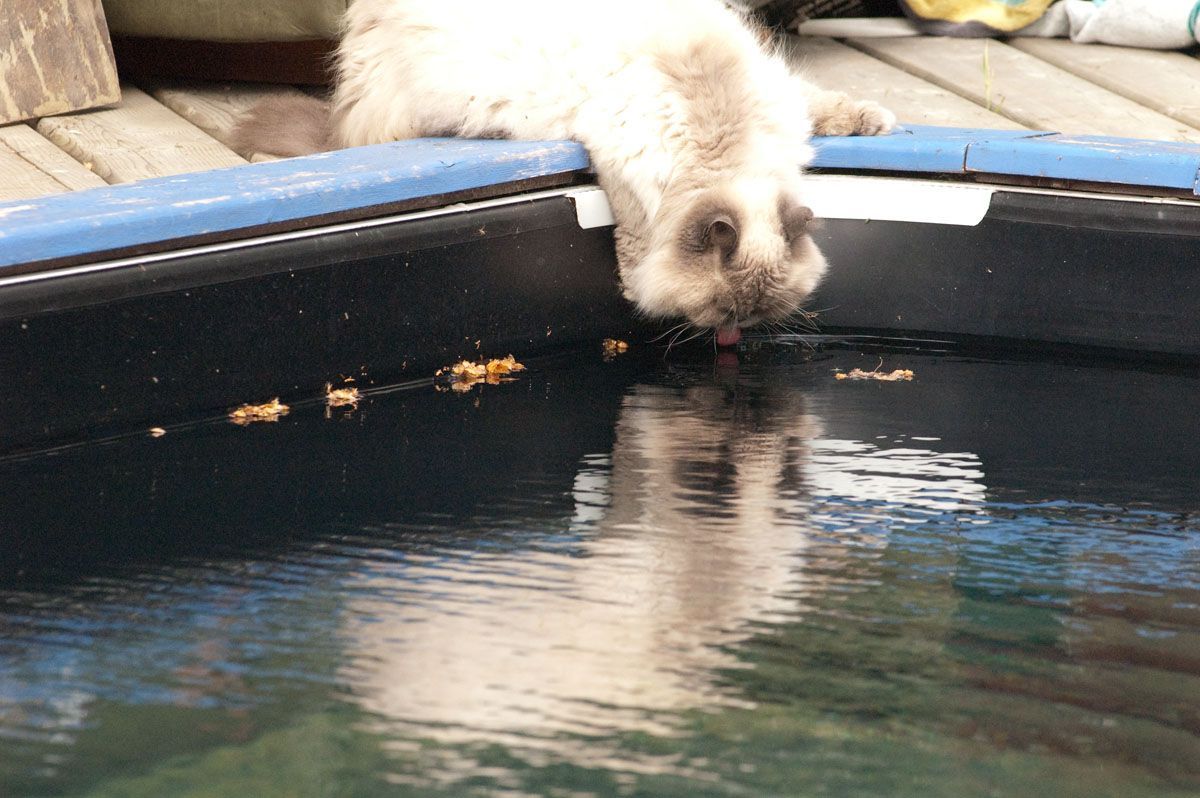
Dear Friends:
Many of you will remember coming to visit us and being greeted by Mikado, our beautiful white fluffy ‘welcoming cat’.... or being smothered with purrs as you slept in the guest bedroom, or cuddled on the couch with a furry white being in cat’s pyjamas. Mikado came to us in 1993 via an SPCA adoption home, age unknown, living up to the name he arrived with -- which in Japanese means “Emperor.” He has certainly ruled our domain all these years. He has tolerated and outlived two other 4-legged interlopers, Lhasa and Tara. His purrs healed us through many difficult times over the years, and he always loved to be in the middle of any activity we were involved in.
Last November this precious furry 4-legged stopped eating and drinking, and we prepared for his passing. We gave him water through a dropper, and TLC constantly throughout five days.
At one point Courtney had a little chat with him, and Mikado passed on some thoughts he wanted to share with everyone. To our delight, he rallied and returned to good health, so we did not pass on his communication at that time.
Two weeks ago he was disabled with a blood clot in his paw which we treated with anticoagulants, and amazingly, he moved into yet another of his allotted lives ... slowed down, but fast enough to bring 2 or 3 mice ‘prezzies’ to us for approval every day. The veterinarian warned us he could throw another clot at any time, but at the estimated age of at least 18 years, we were not prepared to put him through any heroic treatments.
Sadly, today, after cuddles and purrs this morning, we came home to find him unable to move and breathing with difficulty, so we immediately took him to the vet and allowed him to pass on with ease. So it is now time to share Mikado’s legacy, as communicated to Courtney:
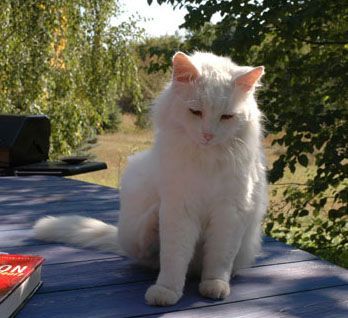
Mikado’s Ten Cat-mandments: With love, August 7, 2008.
Dear Friends: I have had a really great life here and one of the highlights for me has been the love, laps and hugs that I have received from so many of you over the years.
Here are my Top Ten wishes for you:
1. Err on the side of letting others know what’s going on with you, just like you so easily shared the “real you” with me.
2. Take time to cuddle every day.
3. Find someone to sleep with whenever possible [sorry about the drool].
4. Don’t be possessive with your love. Believe me, there is plenty, and more, to go around.
5. When you give love, give completely, as if that person is the only one in the world [you wouldn’t believe how many people think they are my all-time favourite schmoozer].
6. I specialized in reaching out to folks, but there are lots of animals who would also love to connect with you. Please keep a special eye out for us, and allow us into your life.
7. I’ll be corresponding regularly with Sherrill and Courtney so it’s OK to ask them if they’ve heard from me [maybe not for awhile].
8. Don’t be shy about going to the end of your front walk to greet visitors. It’s a way of letting them know how much you have been looking forward to their visit.
9. Know better than anything else what makes you purr, and make sure you are doing/having/getting/creating it frequently in your life each day.
10. Please remember me in your purrs, and even more importantly, keep on purring!
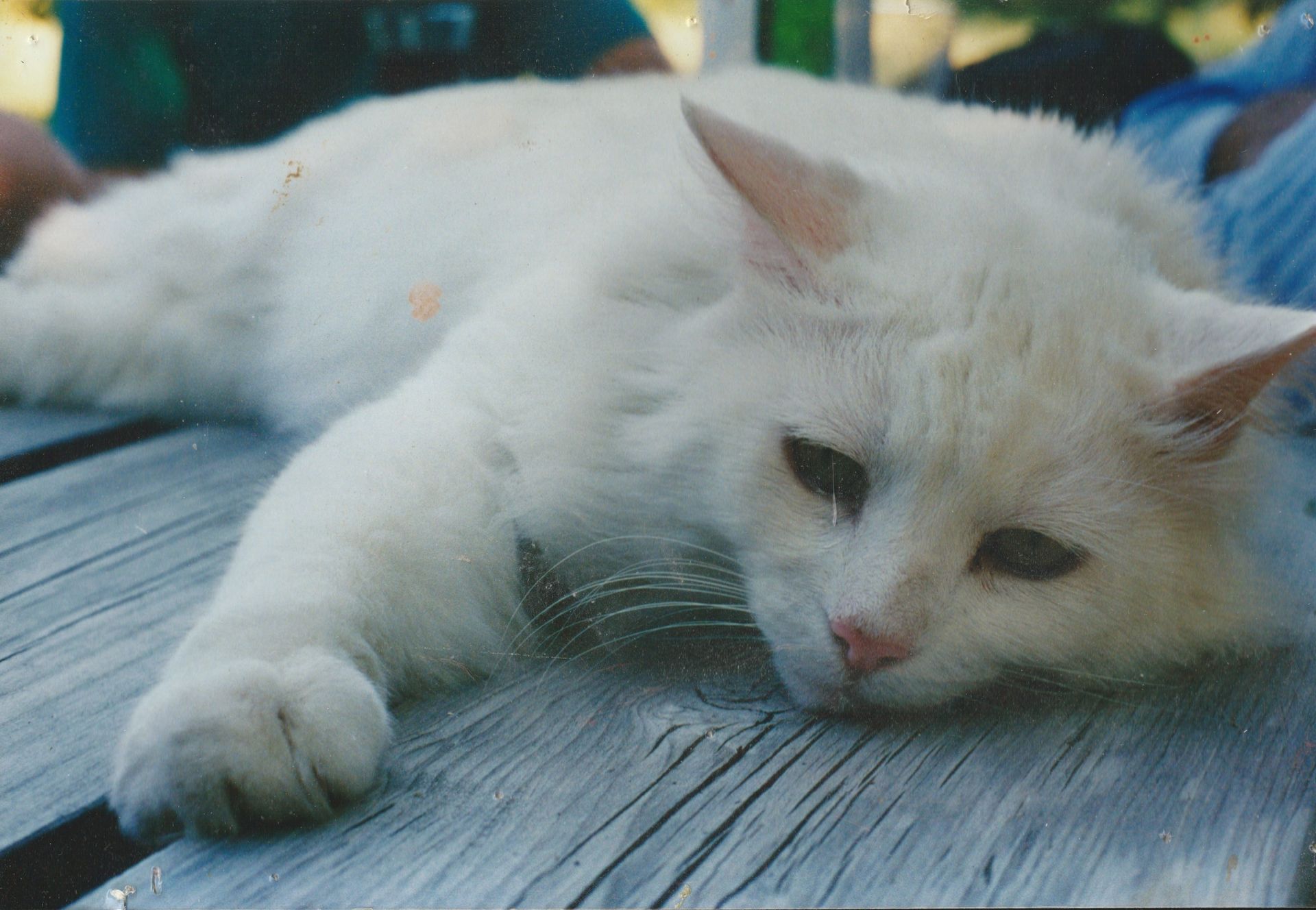

Courtney paced this labyrinth pattern into the snow on the 1999 winter solstice,
... a celebration of the circle of life in anticipation of the upcoming millennium,
made permanent by mowing the paths each subsequent summer.
The Pool Story
The dignity of the artist is in his duty of keeping awake
the sense of wonder in the world
GK Chesterton
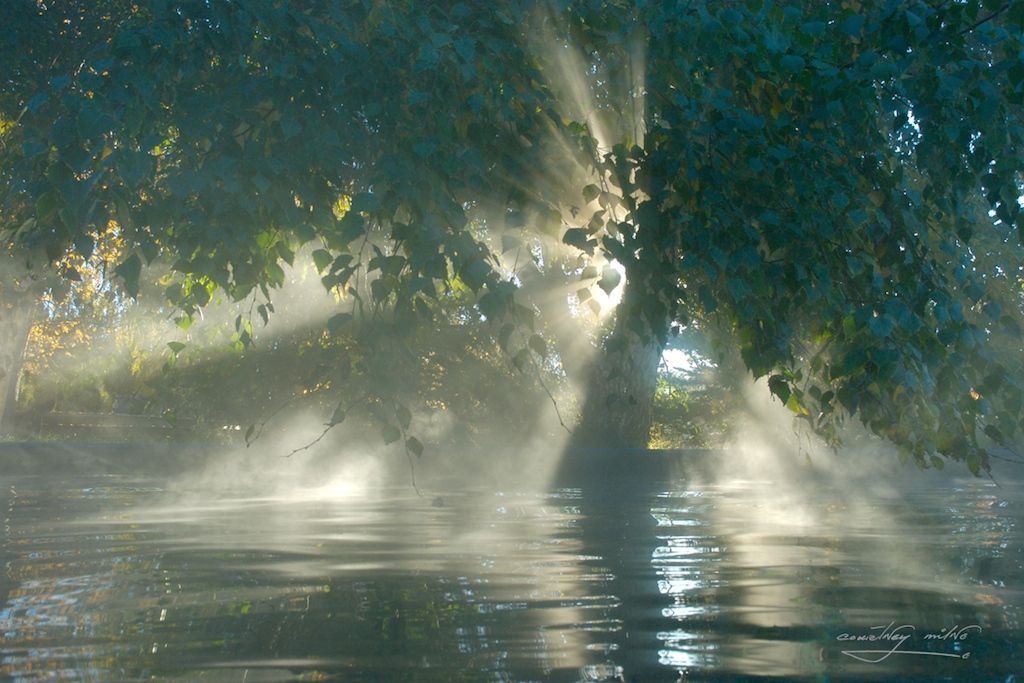
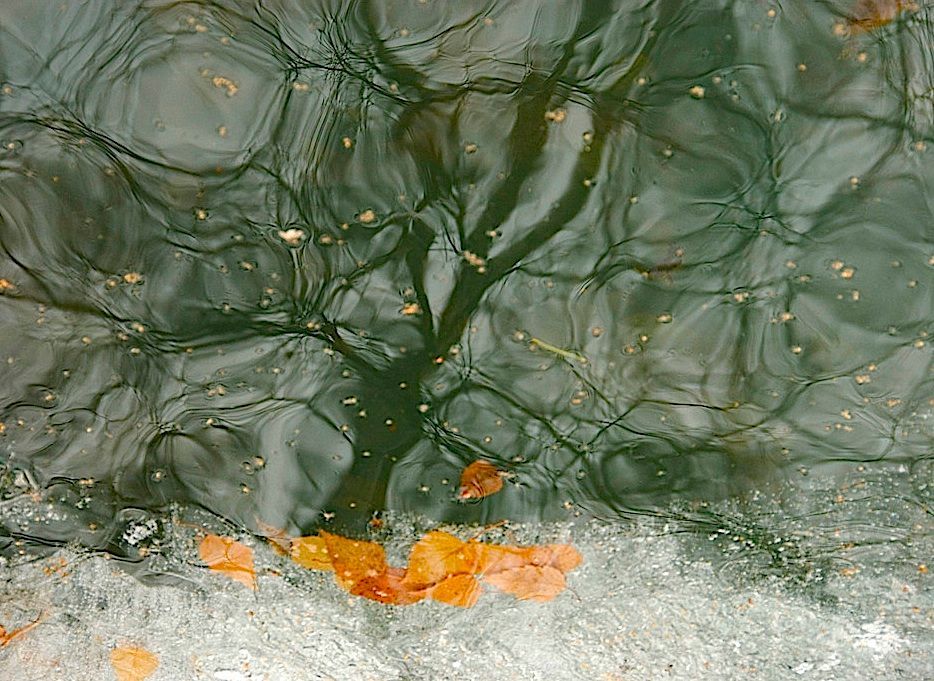
It started serendipitously, as do so many things. We had lived for nine years on our stunning 80 acres of aspen parkland in Grandora, near Saskatoon. The pool came with the house, and was located right outside our patio door. Courtney frolicked in it, had diving contests with the nephews, and an annual birthday underwater swim to test his lung capacity—but he never photographed it. Instead, he celebrated the prairie landscape, and continued to search the world, photographing sacred places on all seven continents. Seven books and hundreds of articles followed, including The Sacred Earth, with a Foreword by His Holiness, the Dalai Lama.
Then on the autumn equinox, September 23, 1999, in anticipation of the approaching new millennium, Courtney decided to “go out in flames,” as he put it, and set himself the task of photographing something every day for the final 100 days of the 20th century. It was a busy time; he was travelling across Canada, promoting his new book,
WO Mitchell Country, and he was home only for brief intervals to change suitcases, when he would “grab” shots of the pool to fulfill his promise. In early 2000, when he reviewed his daily photograph collection, he was stunned to see that his best images were of the pool. Thus, The Pool Project was born.
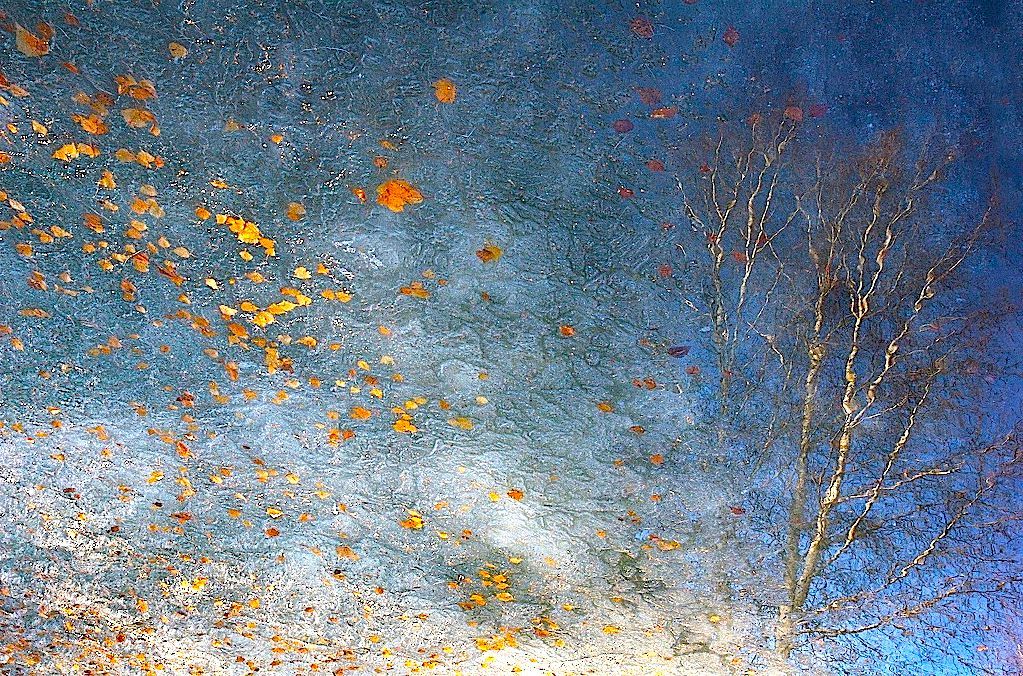
Life continued to be busy with workshops, presentations, photography, and the production and promotion of more books (Old Man on His Back, 2001, and
Emily Carr Country, 2002). In 2005 he produced the book
Saskatchewan, the Luminous Landscape, and Lieutenant Governor Dr. Lynda Haverstock gifted the book to HM Queen Elizabeth and all the dignitaries attending the Saskatchewan Centennial Gala. He was also honoured in the Saskatchewan Encyclopedia, and launched a website of Prairie images for Saskatchewan schools, with the support of SaskTel.
With great modesty and delight, he received an Honorary Doctor of Laws from the University of Regina, with the accolade
an ambassador of the land. Yet he was still drawn to the pool daily, and throughout the seasons. He felt he was continually renewing the boundaries of his seeing, even after 30 years of photography. As the pool continued to seduce him, Courtney switched to a digital camera. Although learning the computer technology was a challenge, it made the increasing numbers of images easier on the budget. All the images in
The Pool Project exhibition are from the digital camera. He rarely cropped his photographs; they were composed and framed in the camera as he had always done. He also made minimal adjustments to the sharpness, saturation or contrast in his images, although he frequently flipped them vertically so the original reflections became landscapes.

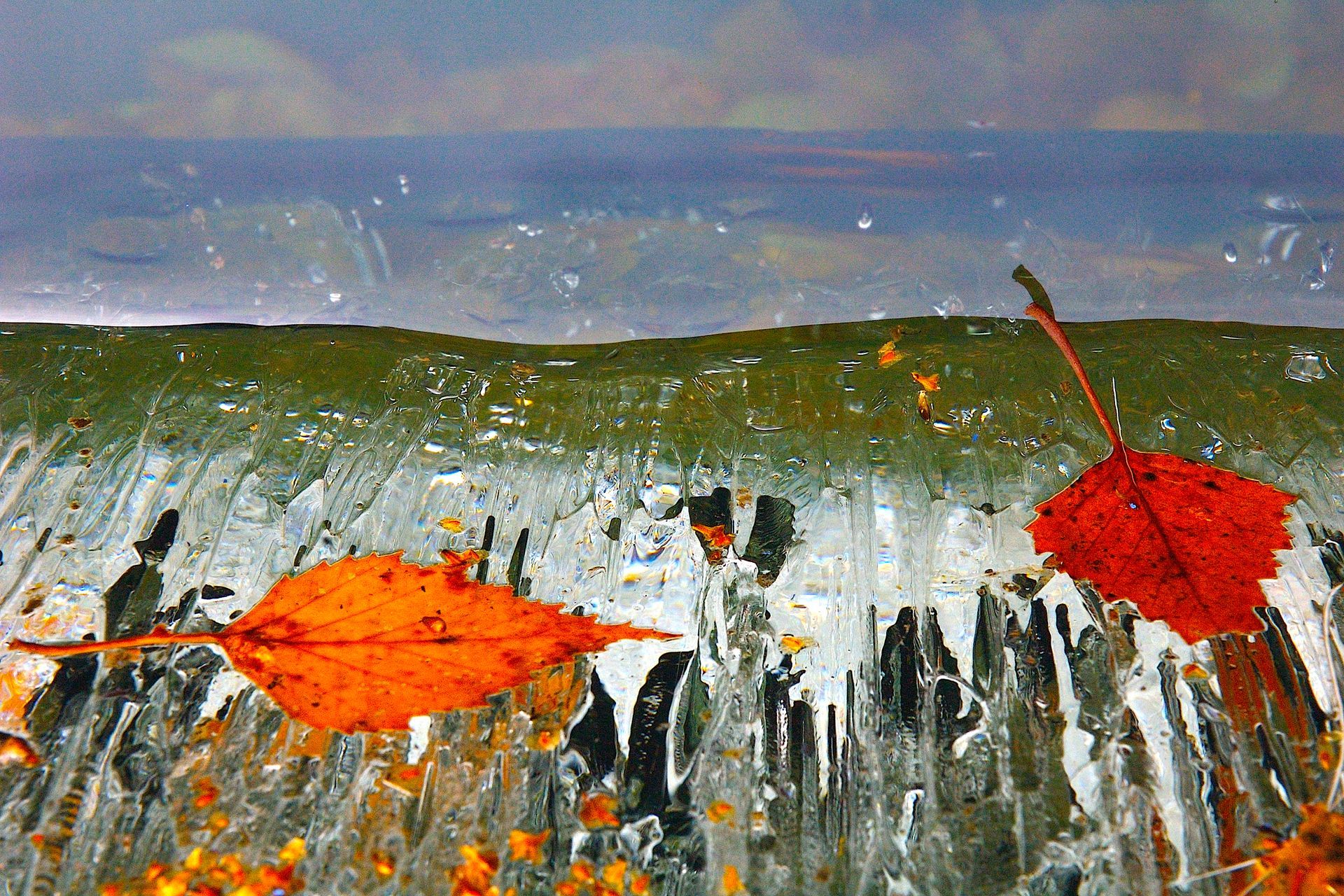
While the parade of the seasons and the feng shui of wind and light on water captivated him, his true joy was this whimsical ability to look at nature's visual feast and see an upside-down world full of magic. Courtney loved building his archive of images; in some way for him it was a measure of his vision. His final total was more than 500,000 photographs of the world’s most beautiful landscapes, 45,000 of which were the pool. The ancient Chinese considered 10,000 to be a very large number, perhaps expressing the notion of infinity. The T’ang poet Ts’en Shen wrote:
When the 10,000 things have been seen in their unity, we return to the beginning ~ where we have always been.
It was in a similar fashion that Courtney, after traveling the world, came home to find it all there in front of him, reflected in the pool in our front yard. He realized his experience was a perfect example of Marcel Proust’s adage that the real voyage of discovery consists not in seeking new landscapes but in having new eyes.
Courtney was somewhat chagrined, knowing that, prior to the pool photographs, he had not followed his own advice that he gave to his students to “first look down and see what is at your own feet.” He wrote this poem:
He searched the world over and what did he find?
That Earth’s greatest treasure is the Eye of the mind.
For when he got home, as wise as a Fool,
He found the whole world right there in his pool.

Most people could not understand how he could create more than 40,000 different images of one small (20 x 40 foot) place—he could hardly understand it himself! He was constantly amazed that he could go out every day and find something new. It was compelling, entrancing, all-encompassing and enchanting, and he so much wanted to share the experience as an example of how others might see their worlds in different ways: “with new eyes.”
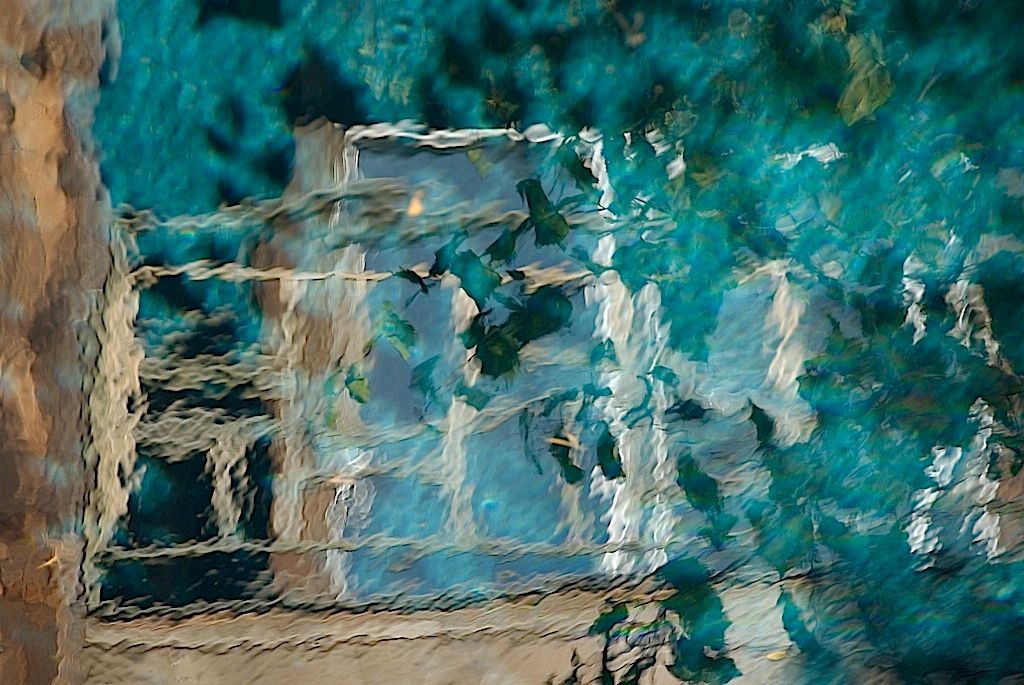

In 2007 we published The Pool of Possibilities, a perpetual online daily e-calendar of 365 different images accompanied by Courtney’s comments, called Poolside Wisdom. He gave each day a name reflecting the interaction between nature and human nature. Then Courtney rearranged the Julian calendar, naming his months for the rhythms of nature and the planetary forces that impact us.
In 2007 he was invited to contribute to a CBC radio program, This I Believe. He said, in part:
This, I believe, is my core ideology: to reveal life’s unfolding mystery — not to try to solve it. In so doing, I help not only myself but also others to connect to their joy and passion. I believe that for each of us, the presence of our being is the greatest gift we can give. Truly accepting and loving ourselves has a ripple effect beyond comprehension.
The Pool Project exhibition at the Mendel Art Gallery has been a wonderful example of this ripple effect. Compare what Courtney said in his Poolside Wisdom about the image he called Fullness, to what Jan Henrikson wrote in response to the same image for the exhibition. Courtney wrote:

This morning as I arrived at the pool, I noticed bubbles forming near the intake pipe. I became absorbed by the ongoing parade of miniature domes—so fragile and fleeting. Their fullness lasted no longer than several seconds, and for the most part they vanished almost as soon as they popped onto the surface. I am reminded that in geological time my lifespan is as fleeting as one of these bubbles—yet the opportunity exists to leave an impression of my fullness.
The bubble in this picture had a life of about three seconds—and I made this photograph somewhere between the second and third. Perhaps it will be a photograph or a piece of writing that will transcend my lifetime and convey my essence to future generations.
What does this bubble express about your life? What words or pictures best portray the fullness of your existence? Sharing your truth makes who you are more tangible.
Courtney lived a passionate life full of exotic experiences. He was the epitome of Mark Twain’s quote: You cannot depend on your eyes if your imagination is out of focus. He was playful, joyful, and full of puns.
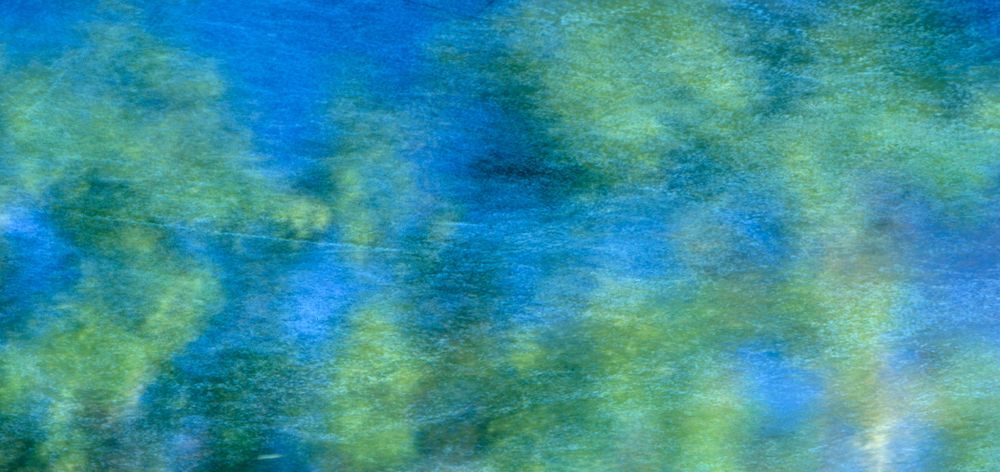
Many people who saw his more impressionistic images exclaimed, “That looks like a Monet!” He would laugh and say, “Thanks for the compliment... sometimes we call them Milnays!” When he was diagnosed with multiple myeloma, I called this “our left-hand turn” into the darkness and mystery. On Friday, February 13, 2009, I was driving home from the hospital and heard this commentary on the role of contemplation in science, by physicist Arthur Zajonc, on the CBC radio show, Ideas:
Every object well contemplated opens a new organ in us...you have to live in that world of phenomena. You have to attend carefully, every object, well contemplated -- not just casually contemplated -- but well contemplated. Attended to, over time, repeatedly, changes who you are—changes who you are to the point where you begin to see things that you didn’t see originally...and perhaps which no one before you has seen.
This seemed to me a perfect description of Courtney’s love affair with the pool, and to the power of the Pool of Possibilities.

For the next 18 months he continued his conversation with the pool, although he never picked up his camera again, saying he no longer needed to record the world, just to be part of the experience. “It’s a part of me and I’m a part of it,” he said. Instead, he worked on the computer from his wheelchair, glorying in the time he had to explore the thousands of images he had not yet had time to review. His excitement was palpable—he was still seeing new things, and many of the images he found were mysterious, otherworldly, mystical. He worked with grace and verve, inspiring everyone around him, and never lost his sense of humour. He chose the images for this exhibition at the Mendel Art Gallery.
He followed the days on his Pool of Possibilities e-calendar. His Poolside Wisdom from September 5th, the day he named Preservation was ironic. Composed in 2007, it was almost as if he had written it for himself at this time:
Some of the smaller pools that I have installed in our yard have only about four inches of water. The whitetail deer love to drink from them, often tracking in sand and fine debris in which they leave their footprints. Long after the deer have moved on, their tracks remain preserved as Pool of Possibilities artwork.
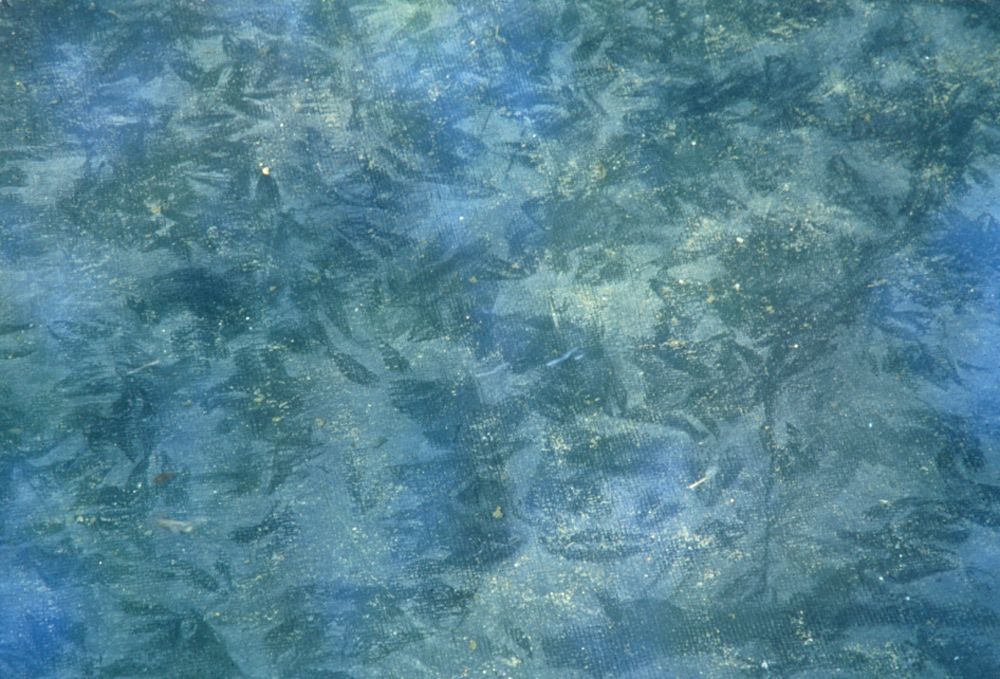
I wonder what traces I will be leaving after I have moved on. Will my prints be worthy of safekeeping? What will be the abiding quality of the marks I make?
Perhaps only history can or should search for the answers, but one thing is a certainty. The quality of the footprint I leave can only be as clear and fine as the original marks that I imprint.
In August 2010 Courtney realized his health was declining. He said he was at peace. The ripple effect he had envisioned was perfectly portrayed in this poem by his good friend Wolf Willow, who had accepted Courtney’s creative challenge and wrote a poem every day as each photograph on the e- calendar arrived on her computer.
This is her second poem for the image called Leaving, November 29th on the e-calendar.
We are drifting, all of us, towards the unknown
it looks like disintegration
we hope it is transformation
it could be imagination
or purification
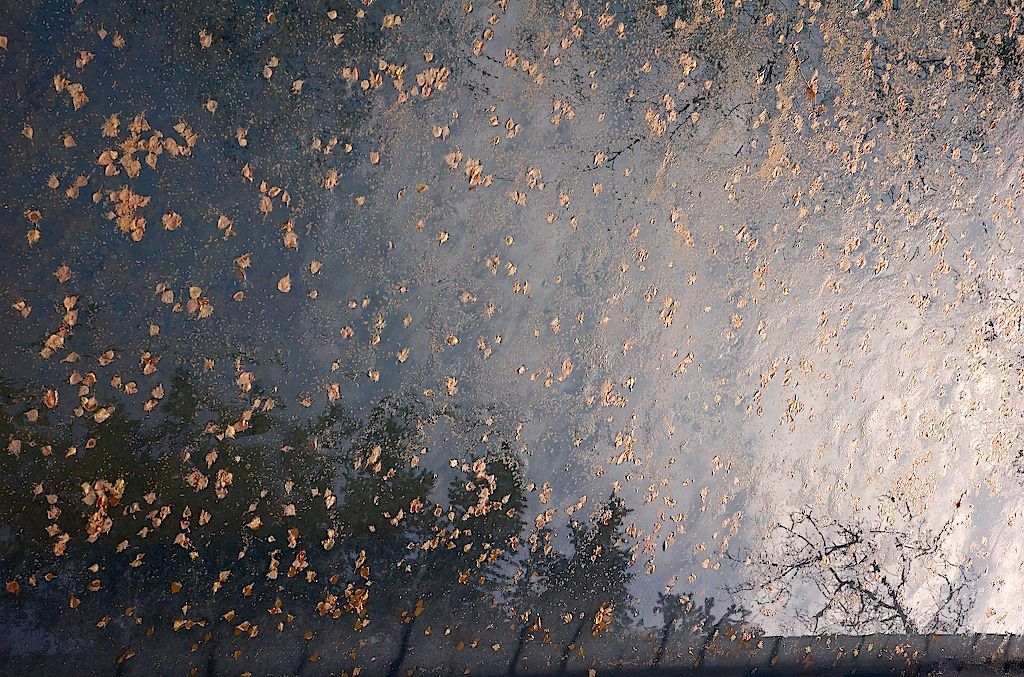
Courtney said that his purpose in life was fulfilled.
He was gratified that his work was done, and had been received.
His last words were: From now on, the heart is in charge.

The Palliative Journey

Photo credit Gene Hattori. Courtney Milne Fonds,
University of Saskatchewan Library, University Archives and Special Collections
First published as Family Care Perspective: Navigating the Palliative Care Pathway ~ how an e-mail chronicled eased the journey.
© Springer Nature Switzerland AG 2019 L. Holtslander et al. (eds.), Hospice Palliative Home Care and Bereavement
Abstract
Sherrill Miller, a nurse with a varied career in business and the arts, was the primary caregiver to her husband, Courtney Milne, during his palliative care journey with multiple myeloma. Sherrill initiated a writing intervention that not only impacted her own experience but also enhanced her ability to cope with the many losses around Courtney’s illness and death. It especially helped relieve her concern that friends and family were grieving, and she could support them by keeping them informed and connected. The immediate impact of this process was profound for Sherrill, but the surprising long-term effects contributed significantly to how she reinvented her life.
See Gift of Change presentation for images and expansion of these themes.
A Personal Odyssey
My early education included an RN and BScN with a working background in various counselling settings, including developing the role of Sexual Health Care Clinician at the Spinal Cord Injury Unit and GF Strong Rehabilitation Centre in Vancouver BC, Canada, in the late 1970s. I think that early work with the devastating losses around paraplegia and quadriplegia primed me to begin to understand bereavement. I also pursued pre-medical studies and then work in psychiatric nursing. I eventually left health care to enter the business world, and later became the researcher, writer, and marketing manager of the photography company established by my husband, renowned Canadian photographer, Courtney Milne. Together we travelled the world and created books, exhibitions and multimedia shows with sacred landscapes from all seven continents. When Courtney was diagnosed with multiple myeloma in 2009, I became his primary caregiver, a situation I called coming full circle, in my being able to use my early specialty nursing training to assist him. During Courtney's illness, we both experienced significant losses and the grief associated with them. Our work together and our exotic lifestyle of travel and spiritual exploration was done. We turned to each other, to the land, and to a few close friends and family, but my heart also ached for our extended families and many friends and colleagues who were shocked and dismayed at how our incredibly creative life had taken a turn into darkness. I then discovered writing.
Writing as a therapeutic intervention during bereavement is often prescribed by counselling professionals.1 [Pennebaker] Some people may write about a trauma or appeal to a higher power at their darkest moment. Writing during grief may encounter obstacles such as lack of time and diminished energy, difficulty focusing, and feelings of overwhelm. It may leave the grieving person feeling more stressed, especially when struggling to acknowledge an imminent death. In retrospect, my writing became a tool for both catharsis and desensitization to the pain of the journey. It kept me ‘in the present’, rather than mired in the losses of our past life. That said, at the time I was more aware of the need to share ... rather than the unexpected outcomes that ultimately allowed me to gain perspective, deepen my own journey, and receive support through this connection with friends.
Now, looking back eight years since the death of my husband, I think the desensitization was a bonus, as was the feeling that we were not alone through this mysterious and rocky journey. Courtney transitioned from a passionate, vibrant, physically active 64-year-old professional landscape photographer, to an invalid in the acute phase, and later to a paraplegic with limited ability to care for himself due to the pain and systemic weakness resulting from the myeloma lesions in his spine. It was a journey of acceptance and grace, nurtured by Courtney’s ever-present sense of humour and our shared sense of hope and possibility. It was a dramatic invitation to employ our long established, but not fully tested beliefs and mantras, including correct, and continue and this too shall pass.
A Phenomenological Process
I think the value of this writing is best seen through a phenomenological approach, a sharing of my “lived experience” of the question. Phenomenology seeks to portray the unique sense of self and highly personal experiences that perhaps can only be described as the art of living. Stories create a rich visual landscape of a lived life, allowing us to share at a deeper level. Telling a story has a bigger mythic impact – a more direct revelation of truth, which can never be fully understood through the words of the typical scientific research model. Perhaps there is no way we can truly and fully understand each other’s journeys. The hidden essence must be felt, and the conversation kept open and evolving through personal narrative. Many cultures rely on ancient myths to understand life’s deepest mysteries. The Irish call mythic storytelling preparation by anecdote.”2 John O’Donohue, the Celtic philosopher/priest said that our task on this earth is to find our relentless originality. He suggests that no one else sees your life, feels your life, or stands on the same ground as you. No one else but you can really understand what that is like … and our uniqueness is both a privilege, and a burden.3 So our stories are a way of sharing our essence.
I have also come to see our life on the palliative care journey as a musical metaphor. It is a symphony of many movements, with a variety of lyrical instrumental voices echoing back and forth, portraying the emotional ups and downs, weaving the texture of the life that is evolving. Courtney and I quickly relinquished the demands of our busy
Allegro tempo work life – cheerful, brisk and lively, and transitioned to
Rubato time, living in response to life, setting our own pace. Periods of
Largo and
Staccato,
Nocturne and
Appassionato were revealed along the way… and finally, for me, an opportunity for
Recapitulation and
Reprise, to review, re-cognize, reinvent and to make meaning in a new way.
In a lecture to nursing students several years after Courtney died, I opened with:
What we are really talking about is brokenness – something like this temple portrays … broken bodies, broken lives, broken dreams. But I wonder -- is there still a spiritual impulse here, despite the damage? Is there still a vestige of the sacred power it once had, despite the brokenness? Does it still carry the mystery and fullness of its individuality? Can we learn to love this mystery, and just be with it? Perhaps this echoes the quote: “some things in life cannot be fixed – they can only be carried”. I think that is very good advice for many times of life, but particularly for the Palliative Care Journey.
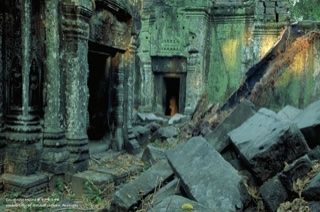
Allegro to Caesura — a break in the music, to pause, to catch one's breath
So the story begins with Courtney’s diagnosis of multiple myeloma, when our Allegro paced life suddenly halted -- we had no idea what the next bars of music would sound like. I became not only Courtney’s primary caregiver, but also the main contact person for our friends and family during this time. I initially started writing not for myself, but because I knew everyone was in shock about Courtney’s diagnosis – they needed information and support, and I could not talk to all of them individually. I did not have the time or the energy to repeat the story of what was happening, and truthfully, I could not cope with their pain. In some sense, they were struggling more than we were because they were at a distance, worrying, and they did not have information or help to deal with their feelings.
Courtney had been in physical rehab for several months when he called a friend from the hospital. She then asked me what she could tell other colleagues so I enlisted her help:
I am starting to let other people know what is happening -- I figure it will be too much of a shock for them later - so better sooner. I just don't want to have to talk to a lot of people ... I know everyone wants to support me but it is harder to have to put out that energy -- I know you understand. So tell anyone you think should know ... just no phone calls please. I know people are sending their love and that is all we need at the moment. I'm so glad he called you and he is reaching out to others. Today is the first day in more than two months that I have had time for myself at home. Whew! It was a beautiful spring day, good for raking leaves, hauling out the hoses, and reading a good book.
My emotional experience is evident throughout the prose, woven into sometimes very practical emails updating loved ones about our challenges and Courtney’s health. An early email demonstrated a resolution to be hopeful:
We don't know what this disease will bring – but it is not a ‘war on cancer.’ Our vision is that Courtney not only maintains his current energy, but also improves his strength and abilities, and becomes involved in his creative projects again. Last year I added Deepak Chopra's comment: 'what would be possible in your life if you were able to see the world with new eyes’ to my email signature, thinking it was an endorsement of the Pool of Possibilities. It has also become a personal daily meditation on miracles, trying to find that place inside ‘where nothing is impossible.’ 5
The Pool of Possibilities project was Courtney’s focus in his last ten years of photography, exploring the interplay of light, wind and nature on the water in our swimming pool. In this body of images he saw the whole world, and all its opportunities – hence the name, The Pool of Possibilities.
I referred to being thrust into the palliative care journey as ‘a left-hand turn’, which was a metaphor for the mystical ‘dark night of the soul’ and the death of our life as we knew it. It was a time of grace, an opportunity to flow in our own rhythm. It made the vast unpredictability of life very real and tangible. I shared some of our early insights:
Perhaps the greatest lesson here is to know we are not invincible, so if you have things you want to do in your life, don't wait -- one never knows where the next left-hand turn will be. Wayne Dyer said it well: ‘don't die with your music still inside you.’ 6
We are learning lessons about really living in the moment, about truly loving oneself, each other and everything around us and being grateful for every moment of every day, and particularly right now, for the glorious spring greens and smells of summer on the prairie.
This optimistic passage captured our thankfulness for each mindful moment, but I have recently discovered it also helped others. One friend and colleague who advised us on alternative health options wrote not only of how the emails helped her cope with her own feelings, but also how they helped her to assist us:
It seemed no matter how bleak the circumstances would have looked to most people, there was always an aura of hope and expectant miracles woven in the lines. So when I could spend time with both of you, I didn't feel like I needed to waste precious time 'catching up.' I could walk right in and know exactly what was happening and carry on the best I could. [MK]
Entering Rubato – stealing time
The emails also served to document the journey of caring for Courtney and offered an expanded understanding of my own and Courtney’s lived experience of his illness, both at the time, and retrospectively. Psychology calls this an experience of meaning making:
The other day the host on CBC radio’s Tempo said that Chopin’s brilliance as a composer was due to his great understanding of the piano. She gave an example of a solo section in a concerto, explaining that
Rubato means "stolen time." This allows the soloist flexibility to take some liberties with his interpretation of the music. I told Courtney that I am practising Rubato ... and we are going to "steal time."
Despite starting as a means of staying in contact to support our friends and family, my email message writing unexpectedly evolved as a tool for many of us to process the grief experience in real time, and to further enhance my understanding of it in hindsight. The emails thus had a therapeutic effect; one friend recently reinforced this with a very poignant comment:
It was important because I was so far away -- it made me feel closer to you all. I remember weeping at times when I read the emails and I wanted to delete them, to make my grief go away.... too bad I'm a therapist and know better! [JG]
I think the emails also gave the recipients time to ponder, to absorb information at their own rate, and gradually process their own feelings. Phone calls had a more informative nature and were more difficult to absorb because of the immediacy and even shock value, not allowing the same opportunity that re- reading an email allowed for emotional processing. It was dealing with this emotional upheaval that I feared I could not offer to others as I was in the midst of similar and constant processing for myself, and with Courtney. Many people said in retrospect the emails reassured them that we were being supported:
Courtney had a huge community generating heartfelt encouragement/support. But that was also influencing YOU supportively. And we also know that those who only witness (are not direct recipients but hear or see some of the stories or pictures, etc.) are positively impacted AS WELL. [LS]
When you hear that a friend is ill, the internal struggle of how best to help begins. Should you jump right in or step back respectfully waiting to be asked? Your emails felt like a guide showing us how to proceed, when to step forward and when to step back. [JL]
Because Courtney was well known and there was a lot of communication between friends and colleagues, one friend observed that the emails helped others to know what was really happening, rather than what they might have heard as second hand information or on social media repeats:
The emails provided the ‘official story’ to a select audience, rather than through social media where you might lose the truth, and the intimacy of a personal connection. [LN]
Courtney and I also had the day-to-day rhythm and ability to make adjustments, so in some strange sense it was easier for us, a gradual moving forward, one step in front of the other into Rubato time. I also realized that writing helped me clarify my feelings and to be more transparent than I might have been in person – I just put it ‘out there’, and also tried to portray how we were adjusting to whatever came along. Writing became a creative act, allowing me to draw from my experience, intuition, spiritual beliefs and positivity … it became a rather poetic way of portraying our life. Most of the writing was my own impressions, but sometimes I included comments from Courtney. It was like a journal ... a diary of our life … a record of his medical situation … and a way of being intimate at a distance:
Courtney came home from the hospital (on a weekend trial visit) last night and is feeling very perky -- we have set up our big king bed in the dining room, looking out the big picture window onto the trees and pool ... last night the stars were awesome! (for those of you who haven't been here, we do not have any curtains to impede the view!) He is managing well and loving basking in the sun through the window ... our duvet is like a spring garden of flowers, so it feels like a Monet experience!
Largo and Staccato – the slow bumpy journey
Our palliative care journey continued over a period of 18 months, portraying the setbacks and successes as Courtney’s illness improved, then the losses as his health dramatically declined. One of Courtney’s favourite teachings in his Seeing with New Eyes photography workshops was ‘telling your story makes who you are more tangible.’ He had always been pretty emotionally transparent, and that continued, and deepened at times, as he/we were called to delve into our feelings. I know the emails helped people to feel more connected to us and to be part of the process, making their (and our) grieving easier, while facing the new realities of our life in a more gradual and genuine way. For example:
They provided a wonderful sense of inclusion and closeness, to keep involved and somewhat aware of the circumstances of your lives, and also gave us opportunity to respond with wee notes of caring. [LH]
The emails made us feel more closely connected with both you and Court during this most sacred time and helped us psychologically and spiritually journey with you in a more intimate way. [JGE]
We were hungry for information but very aware that the demand for updates was taxing for you. We thus tried to hang back and wait. There were times when messages came in so often that I felt overloaded in spite of having my head full of [thinking of] Courtney every day. [AC]
This witnessing and modeling effect of the emails helped several friends in subsequent years to cope with sudden family illnesses and meet their need to keep family and friends informed. One wrote about her own email saga:
It allowed me to be thoughtful, sensitive, and concerned about others, but not overly engaged – with time to think, record thoughts and feelings … to deal with queries, but also protect myself from the barrage of opinions from my family. [EP]
Even with an excellent Home Care nursing team, a major part of my role was being Courtney’s advocate, interfacing with the many services he needed. We were able to borrow a hospital bed from the Saskatchewan Abilities Council. Pain management was a big problem that required medical assessment in the city. I had a prolonged debate with the provincial medical plan to cover a new prescription drug for pain – they finally approved it but ultimately it was not very effective. We lived in the country so every time a problem surfaced such as a bladder infection (which can be life threatening to a paraplegic) we had to go into town for medical assessment. Radiation and other ancillary treatments and evaluations resulted in more trips. That required me to help Courtney make eight transfers each trip, which were exhausting for him (and me): bed to wheelchair, in/out of the car, wheelchair to hospital bed (and reverse on the way home), and a bumpy ride that activated every pain neuron. Even in a wheelchair taxi, in his own cushioned power wheelchair, he felt every rock on our country roads and dips in the city pavement. Sometimes infections resulted in treatment with intravenous antibiotics that I had to learn how to administer at home. This advocacy and organizational role was familiar to me, and despite the added stress, in some way it allowed me to retain and reclaim a sense of my previously efficient self and to have a small sense of control. Falling into the nursing role was surprisingly easy and I recognized how I enjoyed the familiarity of my expertise, being able to help Courtney and establish a routine that would ease the discomfort of his days as much as possible – but there was still much for me to learn and to manage. The palliative care journey had many twists and turns, and like a traditional maze, no clear path to exit.
Despite the ever-present pain, a year later Courtney was much stronger and he yearned for freedom. On his instigation, I packed up both his manual and power wheelchairs and supplies for a month, and with the help of Westjet Airlines we flew to California and stayed with cousins in Palm Springs:
We have been able to adjust, jerry-rig, and figure out the flow of Courtney's care quite easily. The big question, ‘The Bed’, was easily solved with a queen-sized bed with memory foam that has treated his skin well, and there is room enough for me -- we have both been sleeping very well. The head elevates so it makes it easier for him as well.
Courtney is loving it here ... sunny, warm, colourful flowers, a house with a beautiful patio overlooking the golf course -- and he has discovered he can easily 'motor' in his power chair over to the clubhouse, about 10 minutes from here, and take his friends out for lunch. He is glorying in the freedom and ease of moving around in this temperature and with these facilities. Our cousin has taken over most of the shopping and cooking, which has been a great blessing for me!
This was the ultimate Rubato experience. I was also able to enjoy this holiday from the medical regimen, to relish my own solitary ‘stolen’ time. My early back spasms diminished and I played tennis in the sunshine. Late at night I could turn to my writing to clarify my feelings and process the events of the day in this neutral setting. It was a time to breathe, to reflect, to think, feel, understand and integrate ~ more meaning making.
Nocturne - the night journey
We returned in good spirits but later in the spring faced a recurrence of infections requiring hospitalization followed by the need for more intense care at home, as well as the ongoing difficulty in management of pain. He had a series of palliative radiation treatments requiring numerous 8-transfer trips to the city. It was a challenge to accept the limits of the health care situation, and my inability to ‘fix’ things, focusing instead on the things I could do to keep him comfortable and safe.
Courtney had been doing well; he was stronger, we were in the process of buying a wheelchair van, he passed his driving test using hand controls and he was excited about the independence that would give him. Suddenly an unexpected and drastic complication occurred. Courtney developed seizures that resulted in two traumatic 911 emergency calls and ambulance trips to the hospital. He developed speech and coordination problems which became worse … it was not clear if this was the disease process, or if he was overmedicated (to stop the seizures), and I had trouble getting clear medical advice (on a holiday weekend, which was also our 20th wedding anniversary). The daily visit from our home care nurse was an anchor for both of us, giving us a sense of constancy and support during this tremulous and extremely upsetting and confusing time.
At this time I wrote less, mostly because of time and energy constraints, but it was just as important because I knew people would be in shock. I needed to prepare others – and perhaps myself – for this ominous turn. Speaking the words and putting them in writing also made it more real for me. Other emotions that came through in the emails a few weeks before Courtney died are a sense of disbelief at the reality of his declining health, as well as gratitude for things I found to be thankful for. For example:
It is day by day, hoping he will perk up and get stronger again ... I just keep being grateful that he is still here, and can't believe he might not be.
This was my way of acknowledging the possibility of Courtney’s death – to speak it out loud, preparing both others, and myself for that possibility. Looking back on it now, I realize I was being ‘realistic’ with this statement, but not giving in. In fact I continued with this hope almost to the end, saying to Courtney ‘we can handle this – we can learn to live with it’. Some people may have seen this as denial – but for me, it was possibility:
Courtney is not doing well ... he is having more tremors this morning at 0530 ... he is resting now, at 0700, but we need to be prepared for the worst. I just wanted to let you know - I know you will be pretty shocked and upset ... there seems no way around this. Maybe he will settle down, but even if we sedate him heavily, which we don't want to do, this is the likely scenario. I slept beside his bed last night and he was quite peaceful til this happened. So my friends, prepare yourselves - and hope that it will not be imminent. I am just in the moment, knowing I have no control over this.
Even though I was eternally positive and felt we could manage anything, I finally let go of that hope when, after a month of struggling, and becoming weaker, Courtney decided to stop eating and drinking. He clearly said he did not want to live this way – it was ‘time to go.’ His last words to us were ‘from now on the heart is in charge.’
My emails again offered me the vehicle to direct how others could best support us, explaining what would be helpful and what would only cause difficulty, and an email update as circumstances continued to change:
I know you will all be saddened and shocked, and I also know you are sending us much love and support. Please do not feel the need to reply to this. I'll keep you posted as to his progress.
A few days ago Courtney said he did not want any more visitors or phone calls. I have passed on all your messages to him, but the phone is quite disruptive and takes our energy away from him. He knows how much everyone loves him, and he is basking in that.
He did however allow one last visit with some special friends and their 6-year-old twin granddaughters who had loved playing and joking with Courtney. One said to him: ‘Courtney, I don’t want you to die’ and he responded: “remember I will always love you.” The depth of their bond was revealed years later when their mother reported:
You may be surprised to hear how many times his name comes up around here. Just the other day when S. (age 13) was posing for a picture, all of a sudden she decided to reposition into a 'Courtney’ pose … one leg up, arms in the air, and a big grin -- you know the one! We smiled, remembered, got a bit teary, and were grateful once again for the influence of childlike fun he infused into so many interactions. [JB]
This Nocturne space was a sacred time of gratitude and connection. As Courtney gazed out at the pool from his bed, we continued to read his daily e-calendar as a reminder of the impact of his work. Near the end I wrote:
Courtney said he has fulfilled his purpose, and that his work is done. Yesterday morning, with great clarity and directness, he repeated this, saying he was “ready to go” ... and “I have been on the other side a long time”. I know many of you have seen that 'other side' through his images. We can feel the change in energy in this space. So once again, ever the gentle man, Courtney has made it easier for us. We now know exactly where he is at, and do not have to guess. That has been the hardest part for all of us, to not know. He has gifted us with his certainty.
I don’t know where those words of insight came from … the words just seemed to flow into my fingers on the computer. Courtney died at home, surrounded by the beauty and peace he had always known. A friend and shamanic practitioner accompanied him energetically at a distance. Two close friends were in the house with us, holding the space with me – I called us the Guardians at the Doorway. On the day he died, I spoke to immediate family, and then turned again to my email entitled Courtney Milne Oct. 3, 1943 - Aug. 29, 2010:
On the Pool of Possibilities e-calendar this is the day of Appreciation, where Courtney invites readers to: "Observe how the day brightens around you when you share with others what you appreciate about them, with no strings attached, and what you appreciate about yourself, without qualifying your statement."
I appreciate the outpouring of grief and love that is happening near and far. I’m sorry I can’t talk to all of you but it is too difficult. Please don’t try to phone or send flowers. Instead, I would encourage you to follow Courtney’s invitation at the end of his Sacred Earth Concerts – to "find your own sacred place in nature where you feel a connection with the Divine Mystery …a place that you care for and feel connected to, whether in your own back yard, in the park down the street, or a piece of wilderness." Do that in honour of him, and imprint his inspiration in your heart.
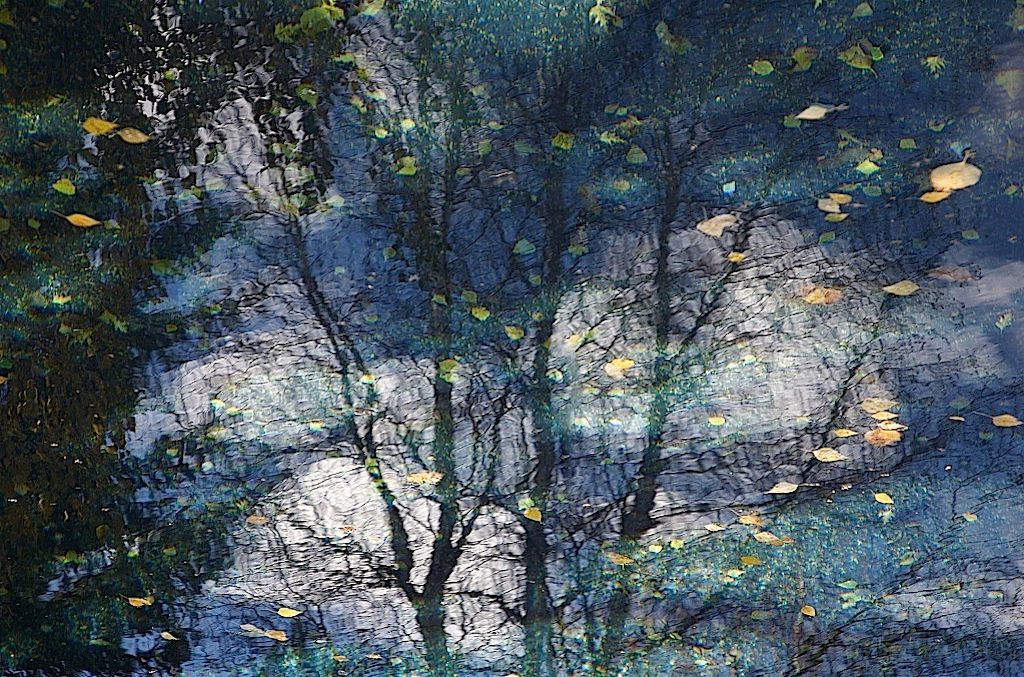
We kept him home for a day before calling the funeral home – this allowed us to take in the reality of his death on a deeper level. Our home care nursing team was invaluable in these final days, walking with us every step of the way. Looking back, I realize I was – and still am - being led by Courtney’s Vision Statement for his work: to reveal the unfolding Mystery, not to try to solve it.
Recapitulation — a retrospective synthesis
On reflection, I think email was the perfect vehicle for me as I already had an extensive list of people who were accustomed to communicating with me in this way. This process may not be for everyone, but it helped me go deeper into my own intuitive wisdom. It also helped me find refuge in the sanctuary we created on our private acreage (10 miles from town). Others might have preferred to gather more people around them, but for us it was important to retreat and become more introspective. We spoke to close family and friends, but too many phone calls or personal visits would have exhausted me (as well as Courtney) because of the emotional outlay I felt would have been required of me. Our home care nurses were vital at this time, giving me a break from caregiving, and giving Courtney another person to relate to. His favourite daily nurse not only matched his sense of humour, but also had a great interest in him as a person, and he loved sharing his work with her. Her visits lifted his spirits immensely, even at the toughest times, and seeing this also helped me feel encouraged.
Being able to write these emails was a relief – for me to portray what was happening, clarify my understanding, share my thoughts and feelings, and not have to put out more energy to talk and repeat the same information to many different people. Even more importantly, I recognized the depth of grieving in so many friends, so this writing gave me the most intimate connection I could offer, but protected me in not having to deal directly with the grief of others. I knew I could not handle that. I don’t think it was a selfish reaction, but one of self-preservation and containment – I needed my energy for myself and for Courtney. Writing was sometimes a celebration, and other times it was finding a way through the chaos.
A blog may be an option for some people but would have been harder for me to set up and monitor, and I feel, less intimate. The email chronicle became my personal journal. In the years after Courtney died, as my brain fog, exhaustion and confusion gradually waned, re-reading this writing has helped me to further understand our journey. Part of my continuing work in various educational settings allowed me to share my story and to integrate the deeper meaning of my losses. Stroebe and Schut’s Dual Model of Coping with Bereavement (2007) portrays the concept of an alternating focus between experiences of loss and activities of restoration.7 For me, teaching and retelling my story helped me to discern what I needed to let go of and what I could bring forward into my new life. Looking back on my writing, I am amazed that my perceptions were so clear – this seemed to crack me open and allow me to share at a deeper level, more than I would have thought possible before. It may have been partly due to less editing of my feelings because of ongoing fatigue. Almost without thinking, the words seemed to flow from a deep well of knowing. This often surprised me as I sat at the computer, asking myself where did that come from, but this has continued to serve me in my writing today. It was like a veil was lifted and it was easier to access my thoughts and feelings, as well as Courtney’s – he had always been very passionate and emotionally transparent, so I just tried to honestly convey his feelings to others (he did not use email so this protected him from having to put out the energy to account to others on the phone). We felt grateful we were not alone in our journey, knowing others were holding us in this space. I now see this opening as an example of Leonard Cohen’s invitation in his song Anthem, to ring the bells that still can ring, forget your perfect offering, there is a crack in everything, that’s how the light gets in.8
As I look back eight years later, I’m often amazed at my words and the profound intuitive knowing they delivered. What began as a way of connecting started me on a creative journey I could not have anticipated. It has become the foundation of the Gift of Change multimedia show that I created as an opportunity to keep Courtney’s photography alive, and also to inspire others who are seeking to reinvent a life after a major change.
In musical notation, recapitulation is a repetition of the major themes; for me this ‘recap’ is the opportunity to ‘to see again,’ to experience and perhaps understand in a new way. Through subsequent years of presenting lectures and my Gift of Change show I have discovered unfamiliar grooves on the spiral of grief. Even now as a write this chapter, I am again re-living the losses, and enter another turn of grief and growth. Despite the sorrow, I actually welcome these dives into sadness as I know they hit pockets of unseen feelings that are important to move out of my body — it reminds me I am alive. It is the rhythm of Appassionato, for myself, and for others. A few of those dear friends on my email list have since died, while others have lost partners or close friends or family. My experience has also helped me cope with their grief, and ease my own new grief. I feel my heart is more open, and I do not need to ask what I call the ‘default’ question: how are you doing; I can sit with the sadness more easily. I understand now that time itself does not heal, but healing does take time.
In the first years after Courtney died many events were held to honour his life. Over those intervening years I continued to write email updates about my changing life and these celebrations such as the posthumous award of the Saskatchewan Order of Merit, the transfer of his work to the University of Saskatchewan Library and Archives, and annual memorial notices in the newspaper. I spent three years creating a catalogue for the Archive, which was both a labour of love and a tool of bereavement for me, providing an opportunity to re-live our life’s projects and tell the stories surrounding them. At the time, I didn’t realize that writing this catalogue was a vehicle for grieving – I thought I was just ‘helping them’ to make sense of thirty-five years of work captured in hundreds of files on multiple projects, a collection of more than 500,000 images, and twelve books. The process allowed me to laugh, to cry, to reminisce, to review, to put our life into context, to conclude our life together, and to celebrate all our accomplishments and reach a kind of completion. This life review brought back many personal memories, and indeed, I joke that if I were to be cheeky, I would say it gave me the ‘last word’ – but it was also a reminder that I had often served in an arm’s length role that is so important to artists, not to ‘interpret’ their work, but to step back and see it in a way that others might better understand.
In 2016 I suddenly realized that my work was done and it was time for me to sell our property and move back to the west coast of Canada where I had grown up. This move brought an amazing insight: I needed to literally move away from my “Courtney and Sherrill” identity to find out who I really was at this point in my life. It has been a time to treasure as well as a struggle to establish this new identity of “Sherrill,” to forge new relationships and make new meaning at the age of seventy. When I sometimes complain about how hard it can be to start over, I try to remember my own advice in my Gift of Change show: the only thing in life that is really predictable is that change will happen, and adjusting to that change revolves around three interwoven tasks: to reclaim oneself, discerning and keeping the parts of one’s life that are still valid and useful today; to reinvent a life with new meaning and purpose; and then to challenge one’s creativity to find ways to re-enchant and enliven that new life that is emerging … and as we respond to the gifts that flow from the changes in our life, we need to discover the wonder, the promise, and the enchantment in our own “Pool of Possibilities.”
Reprise – an Elegy for the ongoing journey
A character from a favourite novel advises: each person’s heart breaks in its own way – and each has a different cure.9 That is such a good observation.
I have come to see bereavement as the process of coping not only with loss of the Other, but equally – and at times more profoundly – is a recognition of the loss of oneself and one’s life as it had been with the Other. It involves mourning this loss of possibility, frequently circling back to the past to what was seemingly lost, sifting through, picking up the pieces and bringing forward what is still useful in the present – establishing what the Buddhists call a Right Relationship with the past … and with the present. The healing of bereavement is about finding that new version of self and re-weaving the texture of that new life.
One major recent insight is that the palliative care journey never ends. Once initiated, it continues to inform one’s sense of the fragility of life … and that is good … and keeps me moving forward. Anniversaries are difficult, prompting old feelings to surface. For the first time this year, instead of writing a memoriam on the anniversary of Courtney’s death, I felt happy to write one to celebrate his birthday. I suddenly realized that the musical form of an Elegy fits here: a sad lament that expresses a feeling. The ongoing journey is about recognizing how grief thrusts us into a keener sense of death, seducing us into the deeper questions of the meaning of life, when one is so aware of the exquisite uncertainty of one’s own mortality. It is about learning how to soften, to ameliorate that fear, and practising how to live again. And as time continues to pass, while aging deepens that search for understanding and meaning, we must find a way to say YES to life, to find our own joy.
Now, eight years later, many friends responded to my invitation to comment on how their life was impacted by my emails. I felt honoured as many expressed gratitude for how our situation thrust them into confronting their feelings about their own mortality, and that my emails were a model of strength and hope that helped them cope with their own grief and fears. One friend, herself a medical doctor, shared several profound comments after going through the recent deaths of several family members:
I do fondly remember your eloquently tender emails. I have been the recipient of such from others undergoing similar situations and it has always felt like a most intimate privilege. My life’s work involved the excavation of the most intimate aspects and events in people’s lives and because of that, I have little tolerance for small talk. There was no small talk in your emails. It was the laying bare the hard facts and lining them up for the purpose of processing. And then heart wrenching examination of the implications and impacts.
… I believe the power of this approach dually benefits the recipients and the writer. The writer’s courage is called upon, banishing denial and temerity. It all becomes part of the current and preparatory grief, though my belief is that the latter is just the broth compared to the elaborate stew that is full grief. And it serves the same purpose, though of a very different nature, for the recipients. The greater benefit to them becomes the teaching about suffering. A wise witness can acquire encyclopaedic knowledge! Just knowing that someone you care about CAN walk the minefield, with individuated style, and survive, gives hope. [LS]
This model of courage and suffering was echoed by another friend who remembered our journey as she faced the recent death of her own husband:
Seeing, feeling, sensing your quiet dignity and peace in the face of death are for me, a model of how I would hope to face death. Being with Courtney through email contacts was a special privilege and blessing. It maintained a connection that had developed over more than three decades, beginning with Courtney as photography instructor, then mentor, and eventually valued and special friend. Over the years, as I photographed or pursued other art endeavours I always had a sense of Courtney ‘being’ with me. Journeying with Courtney through emails in his final weeks remains a daily reminder for me to never neglect the journey. [MW]
So the long-term effect on others was profound, helpful and comforting as time went on and they were called to confront new rounds of grief and loss in their lives. Another friend could not remember the details of the emails, but she still remembered the feelings they evoked. When I commented that her response shows that ‘memory’ is not the only way to embed experiences, she replied:
Feelings last longer than details … I felt like I was a part of the letting go, of the loving circle, of the focused attention on your Highest Good. [DH]
Numerous people recognized how the email conversations pushed them into exploring and expressing their own spiritual questions about life and death. One friend who lives in a religious community wrote:
My reading of your mailing was continued inspiration, peace, and a touch of the Almighty that BOTH you and Courtney could never avoid in whatever you did and said. When someone shows God to me I know for certain that we are indeed created in that image and likeness of God, and that our epilogue will be that moment of recognition and true fullness of life. [MS]
Another long-time friend, photography student and colleague wrote:
Your writing encouraged me to access deeper, more meaningful and spiritual aspects of myself, for which I was very grateful. On a more basic level, it was much gentler to accompany the loving progress of his dying than to suddenly have the shock of an email notification that he had died. Courtney created much beauty in his lifetime, and played a much bigger role in my life than he probably realized; your beautiful writing was a fitting tribute to all that he stood for. [KA]
Another recognized how the continued email conversation over recent years has had a deep impact on how she now views life -- and death:
Parts of our stories continue to be woven together and that fabric provides a comfort, a warmth and a security reminding me that this whole journey through life is a Great Mystery to be embraced -- there is a bridge from the mundane world to the Sacred that lives both in our hearts and our minds. It is our connections with one another that matter most. Every time you reach out I see it as a blessing and an opportunity to keep alive the magic that is our story. You have always stirred me to look more deeply into myself and see more clearly things I might have otherwise missed. [CC]
So this palliative care journey is continuing through my life, taking different forms and turns as the years go by. As I write this chapter, I am still cycling through Recapitulation and Reprise, as the path creates a different composition, perhaps like Shubert’s Unfinished Symphony.
Many books helped me navigate the melodies of the repeating themes in this Reprise movement. Ann Michaels offered a powerful allegory of the process: Grief bakes in us … until one day the blade pushes in, and comes out clean. 10 My blade may be almost clean but I think the scars will always be there as a reminder to live my life to the fullest. This is Kairos time, where I seek to live with a more sacred awareness of the world, through the portals of meandering, pondering, sauntering, recognizing and re-cognizing, while being aware of the underlying mythic patterns that are playing out in my life. It is a life structured more around sensory awareness of the world and the resonance that is embedded within us - our inner landscape - that interior personal mirror that I explore in the techniques of inner awareness work that I call Landscapes of Consciousness. I resonate with poet Rainer Maria Rilke’s suggestion that work of the eyes is done … now go and do heart work on all the images imprisoned within you.11 I also remember Courtney’s certainty that the presence of your being is the greatest gift you can give. And then I remind myself of Mark Nepo’s wise words: there is a sliver of beginning in each of us … you need to lean in softly, with a willingness to be changed by what you hear.12 My new symphony has a variety of themes and variations still being created. I think perhaps it will never be finished.
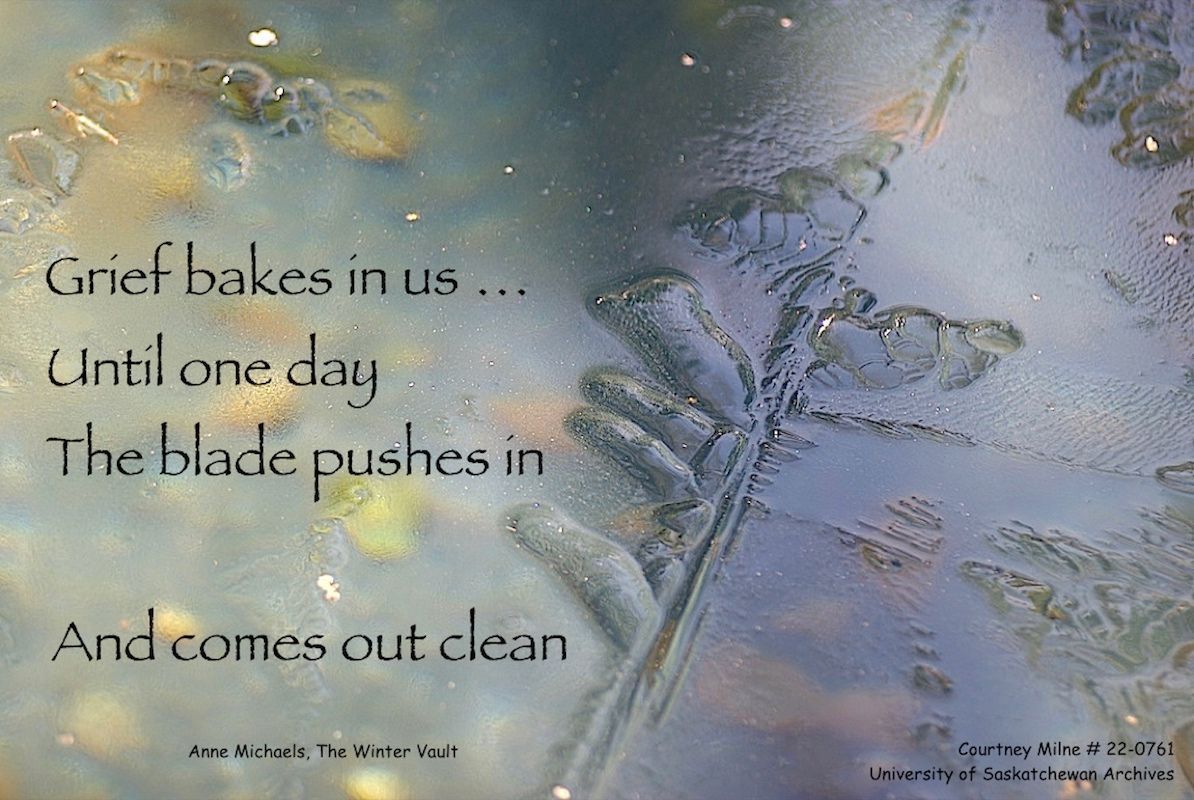
Acknowledgements
Telling this story was prompted through sharing my experience of the Palliative Journey with Professor Lorraine Holtslander at the University of Saskatchewan College of Nursing. I would like to acknowledge her continued support, the assistance of her students Sarah Bocking MSc RN and Kelly Mills MEd who provided background reference material, and Derek Tannis, PhD, for introducing me to the philosophy of phenomenology.
References
1. Pennebaker, J.W. & Beall, S.K. (1986). Confronting a traumatic event: toward an understanding of inhibition and disease. Journal of Abnormal Psychology, 95(3), 274-281. doi: 10.1037/0021-843X.95.3.274
2. Dames, Michael. Mythic Ireland, p. 71. Thames and Hudson, London: 1992
3. O’Donohue, John, estate of. Four Elements: Reflections on Nature, p. 5-6. Random House, NY, 2010
4. Devine, Megan. https://refugeingrief.com
5. Chopra, Deepak. The Seven Spiritual Laws of Success: a practical guide to the fulfillment of your dreams. Amber-Allen Publishing, 1994
6. Dyer, Wayne: Your Sacred Self. William Morrow, NY, 2001
7. Stroebe, M. S., Hansson, R. O., Stroebe, W., & Schut, H. (2007). Introduction: Concepts and issues in contemporary research on bereavement. In M. S. Stroebe, R. O. Hansson, W. Stroebe & H. Schut (Eds.), Handbook of bereavement research: Consequences, coping, and care (pp. 3–22). Washington, DC: American Psychological Association.
8. Cohen, Leonard. “Anthem” from The Future, Sony Music Canada 1992
9. Baumeister, Erica. The School of Essential Ingredients. Putnam and Sons, 2009
10. Michaels, Anne. The Winter Vault. McClelland & Stewart, Toronto, 2009
11. Rilke, Rainer Maria. Turning Point, 1914, poem translated by Stephen Mitchell.
12. Nepo, Mark. Seven Thousand Ways to Listen: staying close to what is sacred. Atria/Simon & Shuster, New York, 2012
Other Helpful Resources
Canadian Hospice and Palliative Care Association. “Reinventing a Life After Loss – a bereaved caregiver’s path through the palliative care journey ~ and beyond.” Webinar, Sherrill Miller, 2016. https://vimeo.com/161823653
The Pool of Possibilities e-calendar background story: http://library.usask.ca/courtneymilne/ecal/poolstory
Information and registration for free e-calendar: http://library.usask.ca/courtneymilne/ecal
Contact the author for more information on The Gift of Change inspirational multimedia presentation and workshops on Landscapes of Consciousness techniques for inner awareness.
Didion, Joan. The Year of Magical Thinking. Knopf, New York, 2005
Fraser, Antonia. Must You Go? ~ My Life with Harold Pinter. Bond Street Books, 2010
Pearson, Patricia. Opening Heaven’s Door – what the dying may be trying to tell us about where they’re going. Random House Canada, 2015
Jenkinson, Stephen. Die Wise: a manifesto for sanity and soul. North Atlantic Books, Berkeley CA, 2015
Gavin Extence: The Universe versus Alex Woods. Red Hook, NY, 2013
Kagan, Annie. The Afterlife of Billy Fingers: how my bad-boy brother proved to me there’s life after death. Hampton Roads Publishing, 2013
Kalanathi, Paul. When Breath Becomes Air. Random House Canada, 2106
Gawande, Atul. Being Mortal: medicine and what matters in the end. Thorndike Press, 2014
Psilocybin treatment to relieve death anxiety:
http://video.newyorker.com/watch/a-reporter-at-large-magic-mushrooms-and-the-healing-trip-2015-02-02

